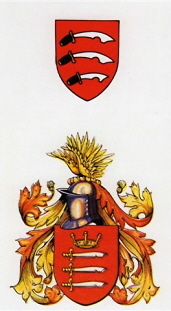Brentford Pubs and Middlesex Coats of Arms
How about "Middlesex Arms" for a Brentford pub?
Middlesex as a County is very old, well over 1,000 years. It separated from Essex, the East Saxons, in 886 but was being called the Province of the Middle Saxons from as early as 705. The County came into being long before most people could read and write, at a time of tribal battles and invasions by warring tribes from northern Europe, among them the Saxons.
The Saxons fought under the sign of the White Horse. This was carved into the chalk hills of southern England and many pubs carry the sign of the White Horse. Brentford had a White horse from at least 1600. Alas, after more than 400 years it lost its historic pub sign when the White Horse became the Weir in 2004. Happily a few white horses survive, etched into the pub windows.
 At some time the Saxons dropped the white horse and adopted a new symbol, the three Saxon swords or seaxes on a red ground (see picture above left). This had been the arms of Saeberht, Saxon King from about 600 to 616. When Middlesex parted from Essex, in the 9th century, both continued to use the three seaxes. The two Counties had identical Coats of Arms until 1910. That year Montagu Sharpe led a move to change the Middlesex County Council arms by the addition of a Saxon crown above the three seaxes (see picture bottom left). A Grant of Arms was made to the County Council.
At some time the Saxons dropped the white horse and adopted a new symbol, the three Saxon swords or seaxes on a red ground (see picture above left). This had been the arms of Saeberht, Saxon King from about 600 to 616. When Middlesex parted from Essex, in the 9th century, both continued to use the three seaxes. The two Counties had identical Coats of Arms until 1910. That year Montagu Sharpe led a move to change the Middlesex County Council arms by the addition of a Saxon crown above the three seaxes (see picture bottom left). A Grant of Arms was made to the County Council.
I have long been intrigued by seaxes. Why do the blades each have a huge notch in the back? What blacksmith would damage the strength and flexibility of his fine forgework in such a way? What could be more impractical in use?

Sketch of Saxon seaxe with hilt missing
A quick trip to London Museums found 5 genuine seaxes, although the perishable hilts do not survive. A trawl through the internet confirmed my findings. The seaxe was not a curved scimitar missing a disfiguring bite but a strong and practical weapon and tool. The blades varied in length from 3 to 30 inches and were straight, unnotched and very sharp. They were solidly triangular in cross-section with a long and lethal point; the larger ones were quite heavy. A few were decorated with linear designs near the back, a very few had an owner’s name.
So when did the notches appear? Next a visit to the College of Arms. Here it was clear that seaxes in early heraldry were straight and unnotched. Only later did they become curved and notched. There was apparently a gradual transition during the 19th century. Possibly there were in that century Heralds of an artistic turn of mind who had, or sought, no access to the genuine article.
The last question was why did the notches appear? The only clue I came across was a description of the seaxe as sometimes grooved. Some blades had lengthwise grooves along or near the back. There could be several reasons for this, one being to lighten it as a weapon. A carefully designed groove would not necessarily reduce the strength of the blade, unlike a notch which cuts across the inner patterning and can only weaken its structure. There is the possibility that at some time “groove” became confused with “notch” with the result we see. A misunderstanding. I should be delighted to receive any comments on this suggestion – which is pure guesswork of course
Middlesex was not administered from Brentford, although justice has long been meted out from its Courts. But many writers have referred to Brentford as the County Town, even the Capital, of Middlesex
As far as I know, Brentford has never had a pub under the sign of the Middlesex Arms – Brentford landlords/ladies seeking a new pub name might like to take note.
Diana Willment
If you have any historical images of Brentford to share, please email them to editor@brentfordtw8.com so they can be added to the photo album. Ownership and copyright will be credited where applicable.
March 5, 2010
Related links
|